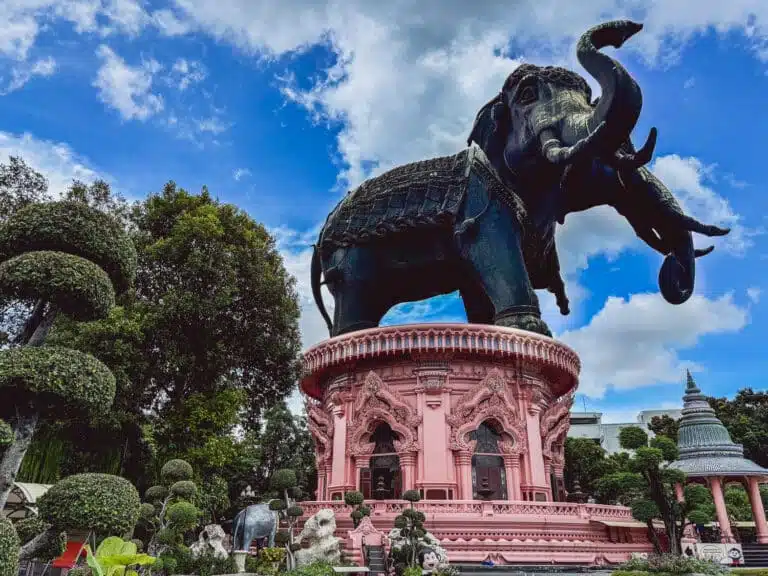Victory Monument Bangkok: the capital’s landmark
In this post, we take you to one of Bangkok’s most important and well-known landmarks – the Victory Monument.
The impressive monument, which sits enthroned in the heart of the Thai capital, is far more than just a memorial.
It is a lively hub that combines Bangkok’s rich history, dynamic present and vibrant culture.

What you should know about the Victory Monument Bangkok
The Victory Monument in Bangkok is a place of great historical and cultural significance.
A few exciting facts about the landmark at a glance:
- Historical context: The Victory Monument was erected in 1941 to commemorate the Thai victory in the Franco-Thai War.
- Architectural design: The monument is characterized by its large central obelisk and five sculptures representing the various branches of the Thai armed forces.
- Artistic significance: The sculptures on the monument were designed by Corrado Feroci, an Italian sculptor who is considered the father of modern Thai art.
- Location: The Victory Monument is located in the heart of Bangkok at one of the city’s busiest intersections.
- Transportation hub: The area around the monument is an important transportation hub and is used by thousands of commuters every day.
- Memorial: The monument serves as a memorial to the soldiers who died in the war and is often used for ceremonies and celebrations.
- Renovation: The monument has been renovated and maintained several times over the years to preserve its significance and beauty.
- Symbolic meaning: The Victory Monument symbolizes national unity and pride and is an important part of Thai identity.
- Tourist attraction: Despite its function as a transportation hub, the Victory Monument is also a popular tourist attraction that offers insights into Thailand’s history.
- Surrounding infrastructure: There are numerous stores, restaurants and street stalls around the monument, providing a lively and authentic insight into everyday life in Bangkok.
How to get there: Take the BTS Skytrain (Green Line) to Victory Monument station, by bus or cab.
Opening hours: Daily around the clock.
Admission: Free
Tip: Book a guided tour to the main sights of the city to learn more about the history of Bangkok.

Experience the Victory Monument in Bangkok up close
The Victory Monument in Bangkok, an important landmark in the heart of the vibrant metropolis, is more than just a monument.
It is a living symbol of history, culture and urban life in Thailand.
In this article, we would also like to look at the various facets of the impressive monument and its role in today’s Bangkok.
Historical background of the Victory Monument Bangkok
The Victory Monument was erected in 1941 to commemorate Thailand’s victory in the Franco-Thai War of 1940-1941.
The structure consists of a large central obelisk surrounded by five statues representing the army, navy, air force, police and civil defense.
Each of these figures is artistically designed and symbolizes the courage and sacrifice of the Thai armed forces.

Architectural features of the Victory Monument Bangkok
The obelisk rises majestically into the air and is crowned by a sculpture symbolizing the spirit of victory.
The entire complex is made of white concrete and marble, which gives it a simple but imposing appearance.
Over the years, the monument has become an important meeting place and a memorial for various occasions and celebrations.
Tip: Book a guided tour to the Grand Palace and Wat Phra Kaew to learn more about Thai culture.
The Victory Monument in present-day Bangkok
Today, the area around the Victory Monument is a vibrant center of city life.
It is surrounded by a variety of stores, street stalls, restaurants and cafés.
The monument also serves as an important transportation hub in Bangkok with numerous bus lines and a BTS Skytrain station.
The lively area attracts thousands of commuters, tourists and locals every day.
Despite its busy surroundings, the monument retains its cultural and historical significance.
It serves as a permanent reminder of the country’s past and is a place where locals gather on national holidays and commemorative events.

How to experience the Victory Monument Bangkok
For visitors, the Victory Monument offers the opportunity to experience a part of Thai history while enjoying the dynamic city life.
A walk around the monument gives you an insight into the daily hustle and bustle of the city.
At the same time, you can admire the impressive structure of the landmark and take great photos.
Our tip: You can also get a particularly great view of the Victory Monument Bangkok from the BTS Skytrain – around the Victory Monument station.
Tip: You can also escape the hustle and bustle of Bangkok for a while on a day trip – for example to Ayutthaya.

Frequently asked questions about the Victory Monument Bangkok
Finally, we answer some frequently asked questions about the Victory Monument Bangkok.
What does the Victory Monument in Bangkok symbolize?
The Victory Monument was erected to commemorate Thailand’s victory in the Franco-Thai War.
When was the Victory Monument Bangkok built?
The Victory Monument Bangkok was completed in 1941.
Who designed the Victory Monument Bangkok?
The design was created by the Italian sculptor Corrado Feroci, who is known in Thailand as Silpa Bhirasri.
Can you visit the Victory Monument Bangkok?
Yes, visitors can visit the Victory Monument Bangkok and explore the surrounding area.
Is there an entrance fee for the Victory Monument?
No, there is no entrance fee as it is a public monument.
What is the best time to visit the Victory Monument Bangkok?
The Victory Monument Bangkok can be visited at any time of day, although it is less crowded in the morning or late afternoon.
How to get to the Victory Monument Bangkok?
The monument can be reached via the BTS Skytrain (Victory Monument Station) and numerous bus routes.
Are there good shopping opportunities near the Victory Monument?
Yes, there are several markets and shopping centers nearby, including the Victory Monument Market.






